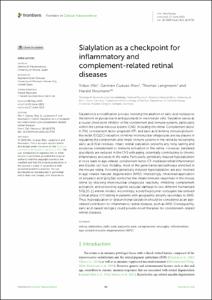Sialylation as a checkpoint for inflammatory and complement-related retinal diseases

Sialylation as a checkpoint for inflammatory and complement-related retinal diseases

| dc.contributor.author | Min, Yiduo | |
| dc.contributor.author | Cuevas-Rios, German | |
| dc.contributor.author | Langmann, Thomas | |
| dc.contributor.author | Neumann, Harald | |
| dc.date.accessioned | 2025-11-07T06:56:59Z | |
| dc.date.available | 2025-11-07T06:56:59Z | |
| dc.date.issued | 27.06.2025 | |
| dc.identifier.uri | https://hdl.handle.net/20.500.11811/13648 | |
| dc.description.abstract | Sialylation is a modification process involving the addition of sialic acid residues to the termini of glycoproteins and glycolipids in mammalian cells. Sialylation serves as a crucial checkpoint inhibitor of the complement and immune systems, particularly within the central nervous system (CNS), including the retina. Complement factor H (FH), complement factor properdin (FP), and sialic acid-binding immunoglobulin-like lectin (SIGLEC) receptors of retinal mononuclear phagocytes are key players in regulating the complement and innate immune systems in the retina by recognizing sialic acid (Sia) residues. Intact retinal sialylation prevents any long-lasting and excessive complement or immune activation in the retina. However, sialylated glycolipids are reduced in the CNS with aging, potentially contributing to chronic inflammatory processes in the retina. Particularly, genetically induced hyposialylation in mice leads to age-related, complement factor C3-mediated retinal inflammation and bipolar cell loss. Notably, most of the gene transcript pathways enriched in the mouse retina, following genetically induced hyposialylation, are also involved in age-related macular degeneration (AMD). Interestingly, intravitreal application of polysialic acid (polySia) controlled the innate immune responses in the mouse retina by blocking mononuclear phagocyte reactivity, inhibiting complement activation, and protecting against vascular damage in two different humanized SIGLEC-11 animal models. Accordingly, a polySia polymer conjugate has entered clinical phase II/III testing in patients with geographic atrophy secondary to AMD. Thus, hyposialylation or dysfunctional sialylation should be considered as an age-related contributor to inflammatory retinal diseases, such as AMD. Consequently, sialic acid-based biologics could provide novel therapies for complement-related retinal diseases. | en |
| dc.format.extent | 8 | |
| dc.language.iso | eng | |
| dc.rights | Namensnennung 4.0 International | |
| dc.rights.uri | http://creativecommons.org/licenses/by/4.0/ | |
| dc.subject | retina | |
| dc.subject | sialylation | |
| dc.subject | polysialic acid | |
| dc.subject | complement | |
| dc.subject | microglia | |
| dc.subject | inflammation | |
| dc.subject | age-related macular degeneration (AMD) | |
| dc.subject.ddc | 610 Medizin, Gesundheit | |
| dc.title | Sialylation as a checkpoint for inflammatory and complement-related retinal diseases | |
| dc.type | Wissenschaftlicher Artikel | |
| dc.publisher.name | Frontiers Media | |
| dc.publisher.location | Lausanne | |
| dc.rights.accessRights | openAccess | |
| dcterms.bibliographicCitation.volume | 2025, vol. 19 | |
| dcterms.bibliographicCitation.issue | 1623755 | |
| dcterms.bibliographicCitation.pagestart | 1 | |
| dcterms.bibliographicCitation.pageend | 8 | |
| dc.relation.doi | https://doi.org/10.3389/fncel.2025.1623755 | |
| dcterms.bibliographicCitation.journaltitle | Frontiers in Cellular neuroscience | |
| ulbbn.pubtype | Zweitveröffentlichung | |
| dc.version | publishedVersion | |
| ulbbn.sponsorship.oaUnifund | OA-Förderung Universität Bonn |
Files in this item
This item appears in the following Collection(s)
-
Publikationen (5)




